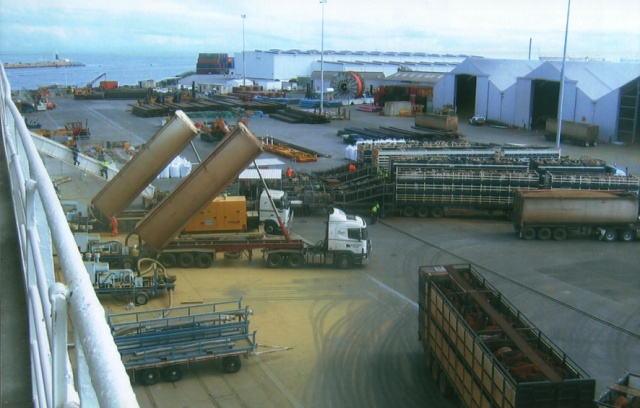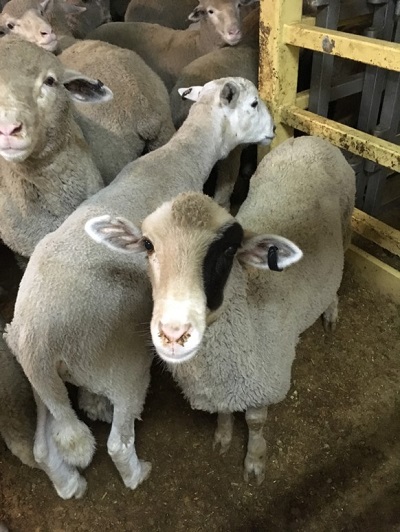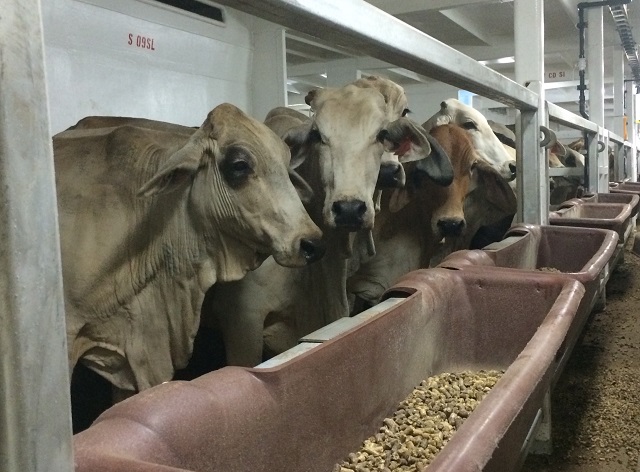Far From the Farm Gate
In Australia's live export trade, the animals' journey from the farm gate can sometimes start with a journey by truck of over 2,000 kilometers (1,200 miles).
Australia's Standards for the Export of Livestock (ASEL) set out health and welfare requirements for transport both by land and sea starting with the on-farm process of selecting animals that are fit to travel. The standards include measures such as prohibiting electric prods from being applied to the face or ano-genital area of animals and the setting of maximum water deprivation times. For example, the maximum on-land water deprivation time of 36 hours for mature cattle can legally be extended to 48 hours if the animals are traveling well. For lambs less than six months old, the corresponding water deprivation times can be 20 and 28 hours.
 Onboard Space Allowances
Onboard Space Allowances
ASEL also sets space allowances for the animals. These are the same or slightly more relaxed for ships than for trucks. For sheep without horns, the onboard space allowance ranges from 0.261 of a square meter to 0.658 of a square meter. In other words, pens of smaller animals can have densities greater than three sheep per square meter. For cattle, space allowances range upwards from 0.77 of a square meter.
In addition to ASEL, livestock vessels must meet the provisions of Marine Order 43 and are inspected and determined to be fit-for-purpose by the Australian Maritime Safety Authority. Stocking densities were removed from Marine Order 43 in 2001 and now fall under the responsibilities of the Department of Agriculture and Water Resources. As regulator, the Department can request and review loading plans at any point during loading, during the voyage should a concern arise or during the review of mortality incidents.
Space allocations can influence mortality incidents through the likelihood of physical injury or the transmission of disease and can influence animal stress, something that can make animals more vulnerable to disease risks.
.jpg) Standing Up and Lying Down
Standing Up and Lying Down
Dr Bidda Jones, Chief Science and Strategy Officer for animal welfare organization RSPCA Australia, says current stocking densities should be reviewed to ensure that they are consistent with allometric principles. That is, they should be consistent with the space an animal occupies as a consequence of its mass when performing normal behaviors such as lying down and standing up. They should also allow for all animals to easily access food and water providers, for visual inspection of all animals and for the identification of shy feeders.
“Current space requirements under ASEL are below the threshold for adverse welfare outcomes for both sheep and cattle, and do not, for example, allow for all sheep to move from a standing to lying position,” she says. “A 50 kilogram sheep is allocated a 0.315 square meter space under ASEL. However, allometric calculations indicate that they need 0.631 square meters for all sheep in a group to be able to lie down at the same time.”
There is no supporting research for how the stocking densities were originally set, says Jones. “The original densities were decided in an abattoir lairage in NSW where merino wethers were run into a pen until it was full of standing sheep. They were then counted. The stocking densities for cattle are based on a similar premise, although there have been some minor adjustments to these over time.”
Jones says mortality represents a complete failure of the transport process. “Using this as a measure completely misses the fact that animals can exist and arrive at their destination alive while experiencing extremely poor welfare.” She suggests that independent onboard studies are required to assess indicators of stress, emotional state and behaviors such as falling, ruminating and panting as a response to heat stress, as well as coughing and sneezing as measures of responses to increased atmospheric pollutants, such as ammonia from excrement.
Mortality
Common causes of cattle mortality are bovine respiratory disease, heat stress and injuries arising from adverse weather and ship factors. The main causes in sheep are heat stress and the salmonellosis-inanition complex. The latter, responsible for 75 percent of shipboard deaths, is a disease unique to the live export industry and results from sheep being unable to recognize and eat the shipboard food, essentially starving themselves and then usually succumbing to Salmonellosis.
Heat stress can be an issue when heading from the Australian winters into Middle Eastern summers. For example, in 2014, 4,000 sheep died of heat stress on the Bader 3 on a three week journey to the Middle East. In 2016, over 3,000 sheep died in a similar heat stress incident on the Al Messilah.
The concentration of animals as part of the live export logistics chain can lead to the rapid spread of disease if it is present, and disease outbreaks have occasionally led to shipments being rejected by importing countries. In 2003, Saudi Arabia rejected a shipment of 57,000 sheep on board the Cormo Express due to the presence of scabby mouth infection. After an initial journey of around three weeks, the sheep spent a further eight weeks at sea and were sent to Eritrea. 5,581 sheep died on board over that time. More recently, in 2012, Bahrain rejected shipments of sheep due to outbreaks of scabby mouth. The Ocean Drover was subsequently diverted to Karachi, Pakistan, where the sheep were eventually brutally culled.
Comparing Mortality Rates
Mortality rates during ocean transport have declined over time through better management and ship design. Some say they are now comparable with or below normal farm rates. In 2016, the overall mortality rate for sheep during sea transport was 0.80 percent (14,182 sheep in 1.78 million sheep exported), with lambs experiencing the highest mortality rate (1.7 percent). A mortality rate of 2.6 to four percent is considered typical for adult animals on Australian farms. So, a mortality rate of 0.80 percent appears much lower.
However, Vets Against Live Export, a organization of over 200 veterinarians, has, after receiving independent statistical advice, suggested that this is not really the case. Comparing an average consignment mortality rate for voyages of variable time periods (e.g. seven to 30 days) with an on-farm annual mortality rate (a 365 day period) is problematic. Whilst the statistics cannot be directly compared, the best option is to compare a 17 day period on a ship with a 17 day period on a farm. If a ship carries 50,000 sheep on a voyage that had a mortality rate of 0.8 percent, 400 sheep died (50,000 x 0.008). If a farm had 50,000 sheep for a year and an average on-farm annual mortality rate of four percent, it would lose only lose 93 sheep every 17 days (50000 x 0.04 x 17 / 365).
Department Action
The Department can place additional conditions on an exporter following a high mortality incident, such as requiring them to reduce stocking density or to load industrial fans. Where stocking densities have been found to be a contributing factor in a mortality incident, the Department has on a number of occasions required changes to the stocking densities for individual exporters, specific vessels or journeys conducted at particular times of the year.
The Department says it is currently undertaking an independent review of ASEL to ensure the current standards, including stocking density, continue to be fit for purpose and take into account the latest animal health and welfare scientific information and advice.
 Welfare Research Underway
Welfare Research Underway
The live export industry has a commitment to research into animal health and welfare, with a number of studies currently underway. Among them, a new, comprehensive industry and government funded welfare project that has just begun under the leadership of Murdoch University's Dr Teresa Collins. The project aims to develop and pilot the measurement of a range of possible indicators across the livestock export supply chain to better measure animal welfare.
Collins says it is a complicated issue to determine the correct stocking density for large numbers and different classes of stock in different pens, on different ships, headed for different destinations. “The standards, of course, are trying to be broad brush and cover the necessary requirement for most animals, but there may be differences in animal needs within the system.”
Her aim is to develop some objective measures of welfare to inform the industry, starting from the departure of livestock from farms and covering their transit to feedlots and ports and then voyaging. This involves developing a practical system for veterinarians and stockpersons to record measurements about the animals. Current recording systems of onboard conditions such as temperature may not be capable of describing the micro-conditions that can be expected across multiple-deck vessels, she says.
The Murdoch team is developing a phone app to aid them in quickly recording assessments and is developing a suite of measures that cover environmental conditions such as temperature and humidity, and management actions such as the provision of bedding and fodder and the frequency of deck washdowns. More uniquely, there will also be animal-based measures about whether animals are eating, lying down, coughing or incur injuries. Additionally, there will be assessments of individual animal's emotional state to determine if they are calm or nervous. These states will be assessed visually but backed up by earlier studies that have correlated behavior with physiological measurements of stress.

Other industry funded research underway includes a project to measure the feeding and drinking patterns of sheep as they make the transition to the new food they will receive on ships. The research aims to mitigate the risks of inanition. Another research project is evaluating different shade structures in sheep feedlots in the Middle East to help manage heat stress.
.png) Non-Industry-Funded Research
Non-Industry-Funded Research
In research not funded by industry, Professor Clive Phillips and a team of researchers from the University of Queensland, have examined how to effectively measure ammonia, temperature and humidity on livestock carriers during the voyage from Australia to the Middle East. Phillips says none of these environmental measures, which can affect animal health and welfare significantly, are currently measured effectively, so he has devised a strategy. For the vessels studied, for example, considerably more ammonia measurements are required on closed decks than on open decks, while the taking of temperature measurements could be much the same.
Phillip's team has also studied the response of sheep to simulated ship movement using a modified flight simulator. Heave movement was found to cause a lot of stress in the animals, and rolling movement caused a lot of stepping behavior. He and co-researcher Grisel Navarro suggest that there are two key stresses caused by simulated ship motion. In the early stages of exposure, sheep push each other in competition for space, especially at high stocking densities and when motion is regular, i.e. they can predict the position of others. In the later stages of exposure, frustration builds with irregular movement and crowding, and aggression results. The researchers concluded that current stocking densities used by industry increased both competition for space and aggression in sheep during the experiments.
Phillips believes his research is an indicator that ASEL stocking densities should be reviewed. Although no ships have been made available to him in Australia to further the work, his experiments are being continued in South America.
The Final Destination
Welfare concerns continue beyond the animals' sea journey. The fate of the animals once they reach their destination has received on-going attention by the government, the industry and in the media. Most recently, in November, Animals International exposed the brutal treatment of animals exported live from South America to Egypt, documenting cases of animals being stabbed in the eyes, ears and legs.
The issue is not new. In 2006, Australia's 60 Minutes TV program broadcast footage of the mistreatment of Australian cattle in Egypt. Exports were subsequently banned but resumed in 2008 following the signing of an MOU which required that cattle be handled and slaughtered in accordance with international World Animal Health Organisation (OIE) standards.
In 2013, trade was again suspended following the release of footage by Animals Australia of the systemic and routine abuse of cattle at two approved Egyptian abattoirs. In 2014, Australia resumed its export of live sheep and cattle after Egyptian importers agreed to abide by the Exporter Supply Chain Assurance System (ESCAS) – Australia's unique regulations designed to prevent abuse and boost animal welfare throughout the live export supply chain.
Concerns have been raised about practices in other countries. For example, in 2015, Animals Australia released footage taken by hidden cameras inside the Dabbah abattoir in Deir Al Asad, Israel. The footage depicts Australian cattle having their tails deliberately crushed and throats sawn. And in 2016, the ABC aired footage obtained by Animals Australia showing cattle being beaten with sledgehammers in Vietnamese abattoirs.
The industry continues to work overseas to improve animal welfare. In November, outgoing Livecorp Chairman David Galvin said he was proud of the industry's implementation of ESCAS around the world. “Pre-2011, less than five percent of cattle in Indonesia were stunned [prior to slaughter]. We're now doing 95 percent of cattle in Indonesia, the same with Malaysia. We've trained nearly 12,000 people around the world in slaughter animal welfare practices. In the Middle East, between two and three million locally supplied sheep are now going through OIE, ESCAS slaughter arrangements put in by the Australian industry.”
He also called for animal welfare organizations such as the RSPCA to shut down their campaigns to end the live export trade. However, regardless of ESCAS and improved rates of stunning, the basic issue remains that welfare and veterinary organizations worldwide believe that slaughter should be as close to the point of production as possible. “There isn't an animal welfare organization in the world that supports the long-distance transport of livestock,” said a spokesperson for the RSPCA.
The opinions expressed herein are the author's and not necessarily those of The Maritime Executive.
